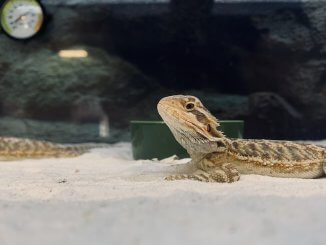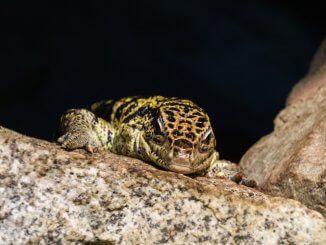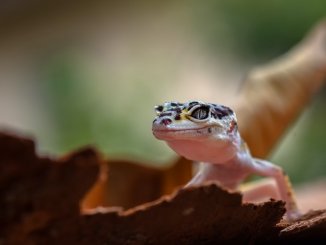Despite their tough exterior, reptiles are susceptible to several diseases, including scale rot.
The medical condition affects most reptiles, although it occurs more often in snakes and lizards.
Understanding scale rot is crucial if you’re a reptile pet parent, especially to boas, pythons, or bearded dragons.
It can save your pet’s life.
Let’s discuss everything you need to know about the disease – from its definition to identification and treatment.
We’ll also give you a few reptile husbandry tips to prevent illness and promote your pet’s health.
What Is Scale Rot?
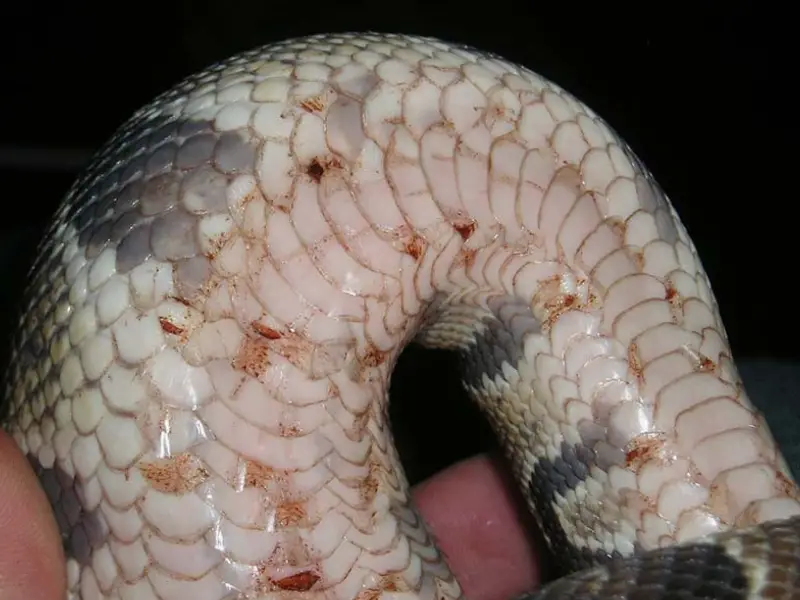
Scale rot is the general term for various scales or skin problems among pet reptiles. Some include:
- Necrotic and Ulcerative dermatitis
- Blister disease
- Bacterial abscesses
- Skin infections due to injury, such as burns and abrasions
This skin problem arises when different types of bacteria like the Pseudomonas spp or fungi attack a reptile’s scales and begin to grow.
Usually, it starts as a small patch on your reptile’s skin. But it can spread to the rest of the body fast as the pathogens multiply.
The more it spreads out, the more life-threatening the illness becomes for your pet.
What Causes Scale Rot?
Since scale rot is a group of skin infections, its causes vary. However, almost all of them are related to poor husbandry practices.
That’s because subpar reptile pet management practices allow bacteria to grow within your pet’s enclosure.
Understanding what these practices are, is essential for you to keep your pet healthy.
You’ll know how to treat the condition and prevent it from recurring.
So, some of the top causes to be aware of include:
Unsanitary Environment
Dirty enclosures harbor several types of pathogens. They contain fecal matter, urates, shed skin, remnant food, spilled water, you name it!
Reptiles can pick up harmful microorganisms from all the waste leading to various health complications, including scale rot.
Unsanitary living conditions also contain stressors that can reduce your pet’s immune response to diseases.
Poor Habitat Regulation
Reptiles, especially snakes, require specific environmental conditions to thrive.
They need surroundings with sufficient temperature and humidity for their bodies to operate optimally.
Poor habitat regulation may lead to low temperatures and high humidity in your pet’s enclosure.
Both factors contribute to scale rot in reptiles in different ways.
Low Temperature
Low temperature prevents the bedding or substrate from drying out completely.
A moist substrate creates the best breeding ground for various bacteria that can cause scale rot.
Also, reptiles need favorable temperatures, i.e. enough heat, to dry their bodies from time to time.
If the temperatures in their enclosures get too low, they might have trouble drying off completely, leading to scale rot.
This is especially true if you keep garter snakes.
Incorrect Humidity
Humidity, on the other hand, helps reptiles with shedding. At incorrect humidity levels, your pet won’t shed properly.
Areas with retained shed become perfect places for skin infections to occur.
This is because the remaining shed constricts the scales underneath it, causing open wounds on the reptile’s skin.
The wounds then become an entry point for the bacteria leading to scale rot.
High humidity increases the moisture levels in your pet’s habitat, preventing the substrate from ever drying out.
A damp environment promotes the growth and multiplication of bacteria and fungi in the area.
Remember, different breeds of snakes require different temperature and humidity levels to stay healthy.
Understand your pets’ needs and regulate their habitat conditions accordingly.
Poor Diet
In the wild, reptiles get their vitamins and minerals from several types of prey.
So try not to feed a captive pet the same thing each day. It deprives them of the nutrients they need to remain healthy.
A lack of essential vitamins, like vitamins A and C, increases your pet’s chances of getting the disease.
Different types of reptiles require a variety of nutrients at various stages of their growth so make sure you’re educated on your pet’s diet.
Damaged Or Injured Scales
When a reptile’s scales or skin is damaged, it’s easier for pathogens to colonize the open areas and cause infections.
Tiny wounds from little scratches, abrasions, or burns can all increase your pet’s susceptibility to scale rot.
These injuries may arise from sharp objects within the pet’s terrarium.
It’s easy to notice damaged scales on your pets and act fast to prevent skin infections.
But it may not be easy to tell whether they have vitamin deficiencies and could get scale rot at any time.
How To Identify Scale Rot
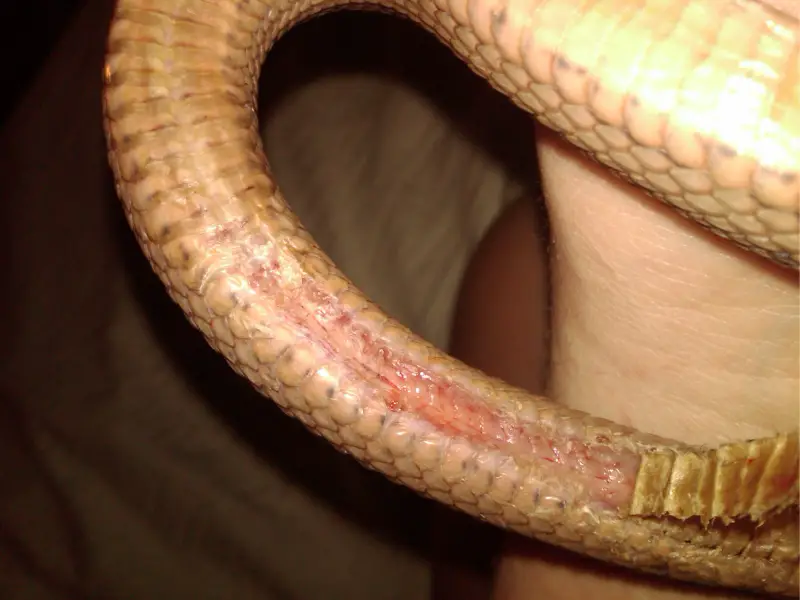
Scale rot appears differently in reptiles depending on their size, the part affected, and the bacteria responsible for the infection.
However, there are common symptoms to help you identify the condition in all reptiles.
These signs fall under two main categories – physical and behavioral warning signs.
Physical Warning Signs
Physical signs, in this case, refer to any changes on the reptile’s body that may indicate the presence of a skin problem.
These signs vary as the disease progresses and can indicate the different stages of the illness.
Discoloration
Scale discoloration is one of the earliest signs of the disease’s onset in reptiles.
You’ll notice a few scales on your pet looking different in color from the surrounding region.
The infected scales may appear red, brown, yellow, or greenish-black.
Changes In Texture
Another early sign is a change in the texture of the pet’s skin or scales. Your pet’s scales may seem dull, cracked, crusty, and flaky.
Most reptile owners confuse this sign with shedding. But the two are different.
In shedding, snakes remove their top layer of scale, i.e. the epidermis only, whereas scale rot affects more than the epidermis.
It might extend to the whole scale and its surrounding skin.
Also, retained shed appears light, like a piece of paper on the scale, while scale rot seems and feels rough.
To identify discoloration and changes in texture on your pet, inspect its ventral and lateral surfaces or tail ends.
In snakes, discoloration can occur on the entire ventral surface because they slither around on their belly in the habitat.
If this happens on a bacteria-filled substrate, getting scale rot becomes inevitable.
As for lizards, check their tails, especially next to the cloaca.
Other areas to look at are the reptile’s head, spine, and neck.
Raised Scales
Your pet may appear to have raised scales on some parts of its body during the onset of scale rot.
It occurs when blood pools around an area due to the disease. The region may also seem swollen.
If you suspect your pet has raised scales, but are unsure, run your hand over its body to confirm.
Be careful and gentle as you do this because the disease is generally painful, and your pet can get more irritated than usual.
Infected Blisters
With time, infected blisters may form on your pet’s skin.
These are raised bumps with clear or yellowish fluid.
They show that the disease is no longer mild because for these blisters to form, the infection must spread past the scales’ surface into the skin beneath.
If left untreated, the infection may spread into your pet’s bloodstream and cause blood poisoning – a condition more formally known as Septicemia.
Septicemia is fatal and can lead to death within a few days or weeks, depending on the size of your pet.
Open lesions Or Ulcers
Open lesions or ulcers may indicate that the scale rot has advanced. Often, they occur when the blisters combine and burst.
They may ooze blood or other fluids and are likely to spread all over the reptile’s body.
You might also notice a foul smell from these infected areas.
Behavioral Warning Signs
Sudden changes in behavior show that your reptile is unwell. There are a few behavioral changes to watch out for, including:
- Loss of appetite
- Heightened aggressiveness
- Slowness or complete inactivity
- Rubbing against surfaces in their enclosures
When you notice any change in your pets’ behavior, consider it an invitation to inspect them for other symptoms of the disease.
How To Treat Scale Rot
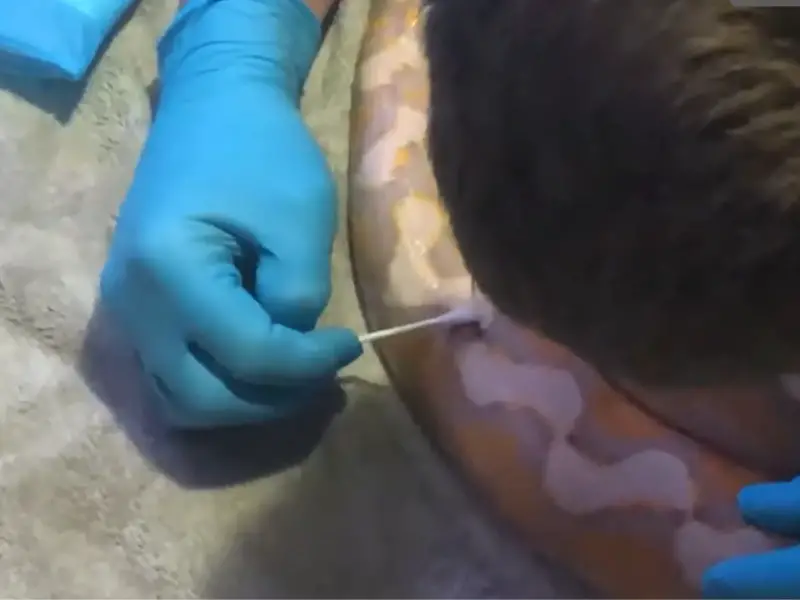
If the infection is at its advanced stages, visiting a vet will increase your pet’s chances of survival.
Vets can administer antibiotic injections to remedy the situation.
They may also sedate the reptile to debride the infected areas while providing supportive care like fluids and electrolytes to restore their health.
On the other hand, if you identify scale rot on your pet at its onset, you can treat it successfully at home.
You’ll need basic supplies like gloves, antibiotic solutions, and cleaning equipment.
Here is a simple treatment procedure to follow.
1. Quarantine
The first step is to move the infected reptile out of the harmful environment and into isolation.
The new environment should be dry and clean, with the temperature and humidity set at optimum standards for your particular species.
Use paper towels as your substrate for the new environment. You want to ensure that it remains dry throughout the treatment.
2. Soak
Soak your pet in a Betadine solution to begin treating the infected areas.
Prepare the Betadine bath on a 1:30 betadine to water treatment solution.
That is, 1 part betadine to 30 parts water. Also, ensure that the water is neither hot nor cold (about 80-85°F).
Then soak your pet in the water for approximately 30 minutes. Keep the reptile’s entire body submerged in the water the whole time.
Once you remove your pet from the solution, pat gently with paper towels to dry them before proceeding to the next step.
3. Antibiotics/ Antimicrobial Spray
After every Betadine soak, apply antibiotic cream on the affected scales. You can also use an antimicrobial spray for this purpose.
Avoid antibiotics with painkillers because they can be toxic to your pet.
Repeat the second and third steps once or twice daily for approximately two weeks until the conditions clear up.
4. Clean And Sterilize The Enclosure
Clean and disinfect your pet’s original enclosure thoroughly. Remove everything and thorough-clean all the items one by one.
Be keen to clean the entire tank, including all the edges and corners, properly using a 10% bleaching solution.
Rinse and dry all décor and hides before putting them back into the tank.
Replace all loose substrates and disinfect all carpets after washing them.
You want to ensure all pathogens are gone, and there is no room for re-infections.
Proper cleaning is one of the most efficient ways of keeping your reptile free from scale rot.
How To Prevent Scale Rot
The goal of prevention is to reduce the risk of your pet developing any skin problems.
The best way to do this is by adopting proper husbandry practices to create optimal conditions for your pet.
Some of the well-recommended practices include:
-
Proper Tank or Habitat Setup
Setting up the home for your pet is essential.
Specifically, pay attention to the type of substrate or bedding you use and how you set up the temperature and humidity regulation mechanism.
Type Of Substrate
Using appropriate bedding for your pet’s enclosure will prevent scale rot and increase comfort for your pet.
The best substrate should:
- Be mold resistant
- Have great absorbing power
- Hold humidity well
- Keep pathogens away
- Break down odor
One of the best bedding options we’ve found, especially for snakes, is coconut chips.
Paper towels and newspapers also work well as substrates.
They are affordable, absorbent, and can be changed easily. But they might not be as aesthetically appealing as the coconut chips.
Controlling Or Regulating Temperature & Humidity
Before creating the best environment for your pet, you need to understand the specific requirements of the species you keep.
As we’ve mentioned, different species require different temperatures and humidity levels to thrive.
However, most species do well between 80 and 85°F.
For temperature regulation, create a cave with a measured heating source to serve as your pet’s sleeping spot.
This spot should always remain at your breed’s ideal temperature.
It is advisable to have other sides of your pet’s enclosure warmer and cooler than the cave.
Your pet requires different temperatures in its enclosure so that it can move around and regulate its body temperature effectively.
Always use a thermometer to monitor your pet’s habitat temperature closely.
On the other hand, consider the following to control the humidity of your pet’s enclosure:
- Avoid placing the tank in areas with direct sunlight
- Cover your tank’s top area with plastic wrap, but leave some part (at least one-third) of the section open
- Ensure your pet’s terrarium has a heating lamp that produces enough heat to dry substrate if necessary
- Lower humidity during heat spells or in the summer by switching on the fan from time to time for a few minutes
Use a hygrometer to monitor the enclosure’s humidity.
1. Regular Cleaning
Regular cleaning is compulsory to keep disease-causing germs from colonizing your pet’s habitat. We recommend the following cleaning tips:
- Look for waste (including feces, uneaten food, and slough) daily and remove it whenever you find something. You’ll need to spot clean more frequently if your pet makes a huge mess
- Check the substrate for wetness regularly and change it as needed
- Deep clean the reptile’s enclosure from top to bottom every month – take everything out and wash with warm soapy water before disinfecting.
- Use razor blades, toothpicks, and knives to clean the hard-to-reach edges of your tank
- Use mild detergents and cleaning supplies to sanitize the entire enclosure without posing any risk of irritating your pet
- Apply a disinfectant to the whole tank, and let it sit for around 10 minutes before rinsing off with warm water. Do this with all its accessories too.
- Clean and treat all rocks and hides. Boil rocks for at least 30 minutes and incinerate hides in an oven.
- Allow all items to dry out completely (preferably in the sun) before putting everything back together, laying new substrate, and reintroducing your pet.
- When reassembling the habitat, ensure it is free of sharp objects that can injure your pet
Remember to use gloves and other protective equipment like goggles.
Also, use different cleaning supplies and equipment from the ones you use to clean your home.
2. Regular Inspection
Inspect your pet often to look out for any signs of scale rot.
If you notice any early symptoms, put your pet in quarantine and start treatment immediately.
3. Proper Diet
Understand the dietary needs of your pet and feed them accordingly.
In most cases, the young ones of different species eat more frequently than the adults.
Well-nourished pets in their optimal conditions have a strong immunity to fight off illnesses.
In Summary
Generally, early detection and treatment is the key to getting rid of scale rot.
And proper reptile husbandry practices are essential for keeping your pet healthy and free from all reptile medical complications.
For mild cases, you should notice significant improvements after seven days. But the skin will clear up properly in about 3 to 6 weeks.
Severe cases, on the other hand, may take months to heal. They require professional handling so don’t hesitate to visit your vet!
Remember, scale rot is a progressive condition. It worsens with time.
The worse the infection gets, the harder it is to treat. Time makes a huge difference in its treatment.

